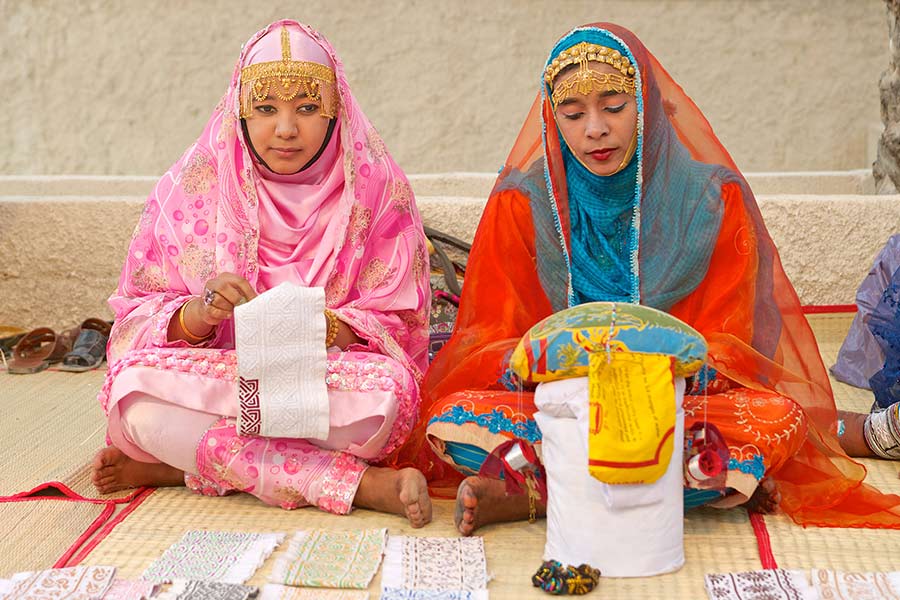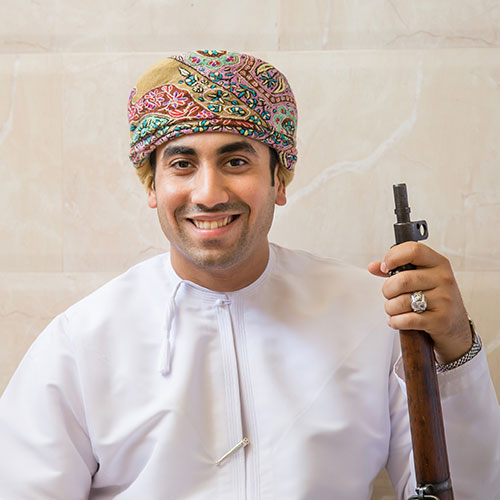Oman’s fashion styles have evolved through the years as a signifier of its cultural heritage and national identity. Each regional and traditional varieties have its own singular characteristics and speak aeons of the cultural diversity and the foreign influence on them.
The traditional dresses of Oman are unparallel and distinguished from that of other Arab Gulf citizens. The features vary according to tribal, cultural and regional identities. They can be distinguished according to the details of embellishment, size or length of the dress, ornamentation, as well as the type of thread, fabrics and fashion.
Before 1970, Omani men and women wore a variety of dresses, which were marked in their type even within a region. But after the ascension of late His Majesty Sultan Qaboos Bin Said, the national dress of Oman began to attain an identity of its own.
Omani Men’s Traditional Attire
The Omani men’s national dress includes a long tunic called dishdasha and a head covering, either a headcloth called massar or a cap called kumma. The kumma is a colourfully embroidered round cap, often worn on its own or underneath the massar to maintain a clean and neat shape. Massars are large square cloths traditionally made of high-quality cashmere wool. They are wrapped around the bare head or around a kumma in a turban style.
Oman is unique in its style in that it is the only country in the Arab Middle East where all male citizens wear the kumma as part of the male national dress. The dress evokes African influences through kumma, the Indian through the massar, and the Arab through the dishdasha. All this integrates into communicating a distinct cultural biography of the national dress.
During formal occasions, men may also wear a khanjar, the ceremonial dagger, at the waist, held in place by a silver-decorated belt or by a shal, a folded cloth that matches the massar pattern. On even more formal ceremonial occasions, a bisht, an overcoat with gold embroidery patterns, is worn over the dishdasha.

The dishdasha can be of white or bolder colours, such as indigo or dark green, as well as pastels. Embroidery in satin or cotton threads decorates the neckline, mahar and continues down the front central opening, shaq, around the wrists, and straight across the shoulder blades and back. A tassel, tarbousha or farakha, is attached to the mahar by a button and is usually scented with traditional perfume. Underneath the dishdasha, men wear a white undershirt and a wizar, a hip cloth wrapped around the waist, with a hemline shorter than the dishdasha. Indigo-dyed dishdashas and those with other deep shades are popular in Dhofar, where a local tradition considers indigo-hued skin (a result of the dye transferring) a sign of luck, protection, and beauty. The wizar is usually white or cream coloured, with a decorative border hemline, in colourful striped patterns.
Omani Women’s Traditional Attire

The Omani women’s traditional dress is more colourful and reveals South Asian and African influences in the use of colours, jewellery, and embellishment. The influence of trading neighbours, immigrant labour force and the homogenising influence of state identity on Omani women’s fashion practices can be seen.

Each dress is different and identifies the community to which she belongs. The regional women’s dress in Oman can be distinguished by the length of the dress or colour of the head covering, or the type of embroidery used. The Bedouin, Belushi, Kamzari, and Marahi women use embroidery in their clothes. Omani women also use a variety of forms in burqas, abayas, trousers, and headscarves in vibrant colours.
There are numerous names for the various forms of head covering in the traditional female dress of Oman. Women in Oman wear the hijab, niqab and burqa. Hijab refers to the head covering while Niqab is the cloth or loose material that covers the face, either fully or leaving the eyes showing. In Oman, this is often referred to as the gheshwa. In the Omani context, burqa refers to the mask-like face-covering usually made of firm material and often worn by older women. The old women in some parts also used to wear shayla. Shayla differs from abaya in that it only covers the upper part of the woman’s body. The Omani dresses in Musandam have badla, an embroidery design influenced by Iranian khus-duzi style, interwoven into their clothes.
The new generation designers have borrowed heavily from the neighbouring countries and have added their fusion into the traditional Abaya. There are two basic forms of the store-bought abaya: the first with tailored arms fitting to the wrist, a neckline frequently featuring patterned embellishment through beading or embroidery and the second, a square cut abaya which hangs like a formless cloak from the shoulder and provides a silhouette less suggestive of the wearer’s figure but may still include embellishment. Modern Omani women love to wear the designer brand versions of the black abaya that includes glittering embellishments. The black abaya is worn in combination with a variety of veils throughout Oman.
The modern Omani women, especially in cities, choose their own style preferences and while maintaining tradition in its purity they also enjoy the broader reflections of fashion seeping into the country.





